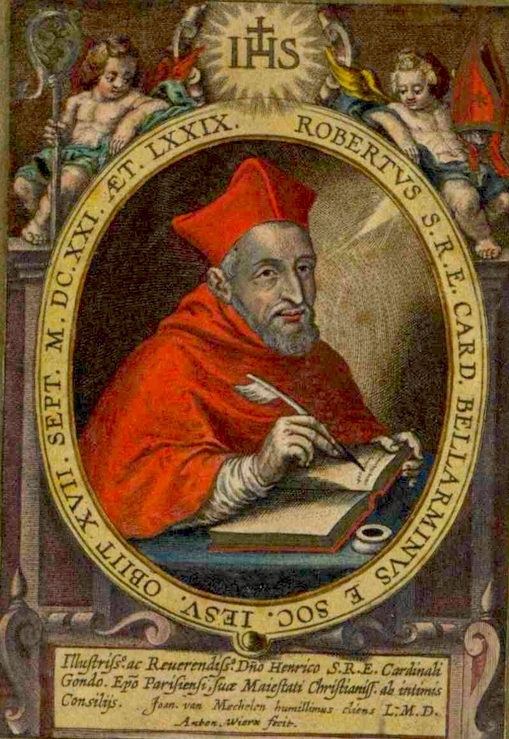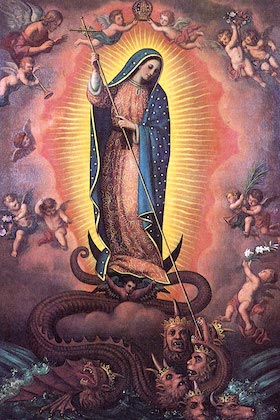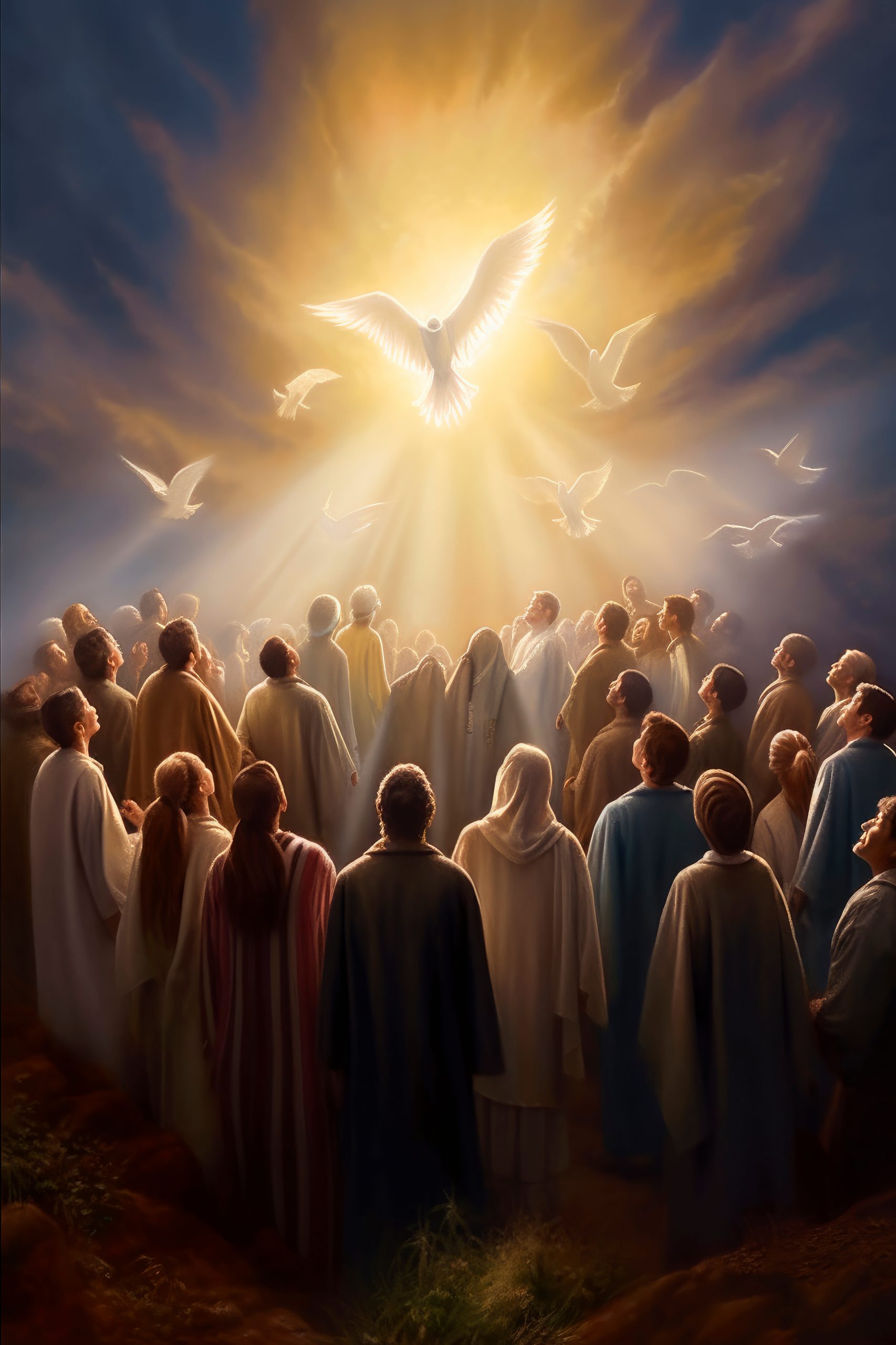+St. Robert Bellarmine+

Happy Mother’s Day Blessed Mother!

(Please read new additions to Mr. Javier Morell-Ibarra’s Catholic Survival Guide here.)
Introduction
In our last blog we focused on the meaning of the male child to whom the woman gives birth in Apoc. 12: 5, pointing out that certain commentators have identified this child as the Pope reigning immediately prior to the coming of Antichrist, (Frs. Berry, Kramer). We also explained the meaning of the “rod of iron” with which this Pope was to rule the Church from heaven, tracing its meaning to word origins and biblical usage.
That this form of explaining the Apocalypse is not any sort of private interpretation or novel method of expounding on this prophetic book is explained in detail by Rev. Bernard LeFrois, S.V.D. in his The Woman Clothed With the Sun (1954, Orbis Catholicus, a division of Herder Books, Rome). Lefrois calls this the collective method and uses it to cast light on further phases of Apocalypse 12, including the meaning of the woman herself, of the wilderness/desert and the great eagle, of the 1,260 days, the woman’s offspring, St. Michael’s role in opposing the dragon and the identity of the true remnant.
The results are both enlightening and gratifying and hopefully will help those trying to make sense of the Apocalypse better understand the methodology and imagery used by St. John. Rev. Hugh Pope, O.P., S.T.M, D.SScr., Professor at the Collegio Angelico in Rome, writes in his The Catholic Student’s Aids to the Bible, Vol. V: “In a very real sense we are now at ‘the last hour.’ The interpretation, then, of the Apocalypse must be governed by the rules which hold good in the interpretation of all prophecy. The full light will not be thrown on this prophetical book till those last things have received their ultimate fulfillment. The book [Apocalypse] is replete with mystery; it is itself the sealed book of Chap. 5… St Jerome says: ‘John’s Apocalypse contains as many mysteries as words… in every single word lie hid many meanings.’ And St. Augustine said: ‘In… Apocalypse, many things are said in obscure fashion for the exercising of the reader’s mind. There are but few points in it, but their investigation opens up a laborious understanding of other points… ”
What follows will show readers exactly how the Apocalypse perfectly applies to those praying at home, providing ample proof of the love and tender care both Our Lord and His Blessed Mother have showered on those of us struggling to keep the faith. The sources quoted will demonstrate beyond a doubt that we are carried in the arms of our Blessed Mother, protected by St. Michael, strengthened by the Holy Ghost, and armed with the weapons necessary to conduct the spiritual combat on earth that, if we pray earnestly for perseverance, will earn our eternal reward.
What is a collective
A collective is “…an object both individual and collective. [It is] not disparate, diverse or unrelated, both together forming a unit or totality. The identical symbol in one and the same passage represents simultaneously both the individual and the collective. Both the Holy Ghost and the sacred author intended it as such… The individual collective is a fluctuation of symbols concerning individual and collective interpretations; neither is to be considered primary or secondary. This commingling of the collective and individual ‘is proper to Hebrew mentality’ (Rohr) or ‘vicarious solidarity’ (Lattey), or ‘corporate personality, where the whole group including its past, present and future members might function as a single individual through any one of those members conceived as representative of it’” (Wheeler Robinson). LeFrois endorses Robinson but relates what Robinson describes to “the semitic total conception of things or thinking of the individual and the species at one and the same time.” He also refers it to types.
This solves the problem of the Protestant interpretation of Apocalypse, which held primarily to the ancient context in which it was written, or to events that have already passed (historicism). St. Robert Bellarmine and other Jesuits taught that Apocalypse rather predicts future events culminating in a period occurring immediately prior to the Second Coming — the futuristic or Catholic interpretation of Apocalypse (also the book of Daniel and 2 Thess. 2). Collectivism gives the sacred book a wider scope of past, present and future. As Rev. Jean-Pierre de Caussade observes in his Abandonment to Divine Providence, it is a continuing cycle repeating itself until the final consummation. Collectivism is seen in the Apocalypse’s mention of the seven churches, the two witnesses, both Mary and the Church as the great sign, the beast with seven heads, and in other verses.
The woman and the popes
“And a great sign appeared in heaven: A woman clothed with the sun, and the moon under her feet, and on her head a crown of twelve stars.” (Apoc. 12:1)
For centuries, commentators generally interpreted Apoc. 12:1 as referring primarily to the Church. But in his definition of the Assumption, Pope Pius XII described Our Lady as “…clothed with the sun and crowned with stars.” Pope St. Pius X also indulgenced a prayer that reads in part: “O Mary, crowned with stars, who has the moon for your footstool and the wings of the angels for your throne…” (AAS 37, 1904-1905). While LeFrois does not credit this as an official interpretation of Apoc. 12:1, he quotes Pope Pius XII in Divino Afflante Spiritu as encouraging exegetes to find a new solution to the interpretation of this verse, since many more modern authors began associating it with the Blessed Mother. LeFrois provides a lengthy list of these. In the collective sense, Mary can be seen as the woman giving birth not only to her Divine Son, but to all the members of the Mystical Body after Christ’s death on the Cross. It is most fitting that Christ placed His Mother in St. John’s care, and St. John in His Mother’s care, embracing the entire Church — fitting because it was this very apostle who gave us the Apocalyptic visions.
LeFrois calls Our Lady both an individual and a collective, “an arch-type of the Church… clothed in the fullness of the Divinity… [She] alone conceived the entire Christ, both head and members, to be mother of all the living.” LeFrois insists, however that the male child she bears in Apoc. 12: 5 can only be the Messiah Himself, symbolizing the joint rule of God with Christ. The “rod of iron” he defines as the rigor Christ will exercise in the end to punish and judge His enemies. But if we apply the collective method to this verse, how can it not also refer to the pope then reigning, who is “taken out of the way” (2 Thess. 2: 7)? For while Our Lady gives birth to the Messias, it is the Church, already part of the collective, which, in like manner, “gives birth” to the pope. This is what Frs. Berry and Kramer believed, and what Henry Cardinal Manning taught would occur shortly before Antichrist reigns. This pope, of course, would be one of the members Our Lady conceived, belonging to the Mystical Body, the actual earthly head of that Body; the very member who defined the nature of the Mystical Body in Mystici Corporis Christi.
The pope and Christ rule dually as Head of the Church on earth. As Pope Pius XI stated: “You know that I am the Holy Father, the representative of God on the earth, the vicar of Christ, which means I am God on the earth.” LeFrois simply failed to extend the collective method directly to Apoc. 12:1, perhaps to avoid controversy. Other commentators, however, did so apply it, and we have seen that their estimations more closely fit the circumstances we experience today.
The 1,260 days in the wilderness
“And the woman fled into the wilderness, where she had a place prepared by God, that there they should feed her for 1,260 days” (Apoc. 12: 6).

(River in tundra, Alaska)
Revs. Berry, Allo, LeFrois, and the Fathers Lactantius and St. Hippolytus all maintain there will be two separate 1,260-day periods where the Church will be protected from the full brunt of Antichrist’s torments. (St. Augustine says these days can mean any length of time, according to Fr. Arminjon, as does St. Bede, and LeFrois and Heidt, among others agree). The first period follows the invalid 1958 election and is set in days but appears to be an indefinite period — three- and one-half years. The second time-period mentioned is referred to as a time, times and half a time, or the entire time.
LeFrois explains: “Oddly enough, there is no mention of the time element of three and a half years in the book of Kings where the life of Elias is recounted… but only of ‘many days’ when there was no rain. Hence it seems that the phrase three and a half years is a technical symbol, which does not wish to express so much a period of time as a period of tribulation and woe, (emph. his). This of course does not exclude the idea that it is a period of time, but it clarifies the issue that three and a half years are not to be taken in a literal sense.” Abbe Constant Fouard, in his St. John and the Close of the Apostolic Age notes that: “These three years and a half, the half of seven, the number signifying perfection, denote an imperfect time which will not be completed.”
LeFrois quotes a J. Bonsirven in support of this statement. He continues: “The peculiar detail of 1,260 days, which is intended to be the equivalent of 42 months as well as three and a half years, may refer simply to the Messianic era in its entirety, considered from various angles, (Rev. Allo).” So Rev. Allo also agrees with this interpretation of the 1,260 days or 42 months as an indefinite time period. One Father, St. Augustine, states that, “…The word day in Holy Scripture is to be understood in the sense of any length of time,” (Malachias 3: 1,2;” The End of the Present World and Mysteries of the Future Life, Rev. Charles Marie Antoine Arminjon, 1881). The first time the Church shelters in the wilderness (Verse 6), the second time in the desert (verse 14). Revs. Kramer and Berry opine the wilderness is some non-Catholic nation signified by the great eagle but Kramer also identifies the two wings as those of St. Michael, aiding the Church, as does Rev. LeFrois. A few other commentators suggest this as well.
This could indicate the St. Michael Prayer abrogated by the false Vatican 2 council in 1964 and officially abrogated with the institution of the Novus Ordo Missae in 1969, when many finally realized what the V2 changes really meant and began to exit the Church. As mentioned before, the three years and a half (1,260 days) all assume to be the brief duration of Antichrist’s entire reign is described by many commentators as only the heighth or pinnacle of his reign of (spiritual) terror. This might be counted from Paul 6’s victorious address to the United Nations Oct. 4, 1965 — two weeks after the passage of the schema on religious liberty by the council fathers –1,997 to 224 — to the official promulgation of the Novus Ordo on April 3, 1969: this is almost exactly three years and a half. After leaving the Novus Ordo church, Catholics found themselves wandering in the wilderness. Wilderness, in this sense, could mean (at least a temporary) cleansing from “all inclination to idolatry” (Fr. Kramer) as was the case with the Chosen People in the wilderness or desert. But of course, this did not last.
Wilderness defined in detail
LeFrois, by cross-referencing wilderness to its root origins and usage in Holy Scripture observes that basically wilderness means “being solitary (from the Greek), which could translate to “on your own.” It is also a “solitary place devoid of people,” or with only “a few inhabitants.” For Our Lord, the wilderness is “a solitary place well-suited for communion with God.” It can also mean “a place of refuge for the persecuted, a woman desolate because she is without children.” It also suggests disobedience and chastisement (1 Cor. 10:5, 6-11; Heb. 3: 8, 3-17;Ps. 77, 78). If wilderness is seen as a conviction that one can only pray at home to observe God’s laws, then certainly it can serve as a fitting penance for previous disobedience to those laws as well as a chastisement for all Catholics, in losing the Mass and Sacraments. In this sense we might view ourselves as scapegoats, sent into the wilderness in the Old Testament bearing the sins of the people (Lev. 16: 1-34), there to perish for the sins of others (by martyrdom of blood or of spirit; the “white martyrdom” St. John himself experienced as a result of his exile to the isle of Patmos). Christ Himself has been called a scapegoat, for He took upon Himself all of our sins. We should therefore wear our exile as a badge of honor.
But LeFrois paints a more glorious picture of this wilderness/desert experience, writing that: “Wilderness implied par excellence God’s special divine Providence toward Israel and her delivery from the enemy through God’s intervention (Jn. 3: 14, 6:31, 49; Acts 13:18). Also 3 Kgs. 17:2 and 19:3 and the Didactic books of Psalms and Wisdom refer to the wonderful things wrought by God for His people in the wilderness. The Messiah was to make His appearance in the wilderness in proper sense of the word, but reactionary forces also associated themselves with the wilderness and our Lord warned them against this: “If they say to you, ‘Lo, he is in the wilderness, do not go out,’” Matt. 24:26, (Ed — A pointed reference to Traditionalist reactionaries who took matters into their own hands). “But Apocalypse depicts the wilderness as a place of refuge for the woman fleeing from the dragon and in pursuit of her. So wilderness is not literal but symbolic… Wilderness implies God’s special divine Providence and intervention by which the woman is sustained in life until a period of trial and tribulation is over.” And yet it can be said in our case to apply literally in a sense as well.
LeFrois then quotes the Bible verse that Protestants use to justify the rapture, for the REAL RAPTURE lies in God’s miraculous intervention and Our Lady’s protection of her children on this earth. LeFrois continues: “The wilderness is a definite place or state. The woman is inviolable against attacks of Satan not only by means of her being carried away to a place prepared by God but also by means of the earth coming to the aid of the woman and swallowing up the river the dragon had poured from his mouth” (Apoc. 12:16). He then describes how God sends the woman (Mary and the Church) “…special divine protection through angelic assistance and she is kept miraculously from harm and destruction.” While being sheltered in the wilderness with Our Lady, which LeFrois refers to several times, the faithful are miraculously protected. Eagle wings, he says, points to the extraordinary. And although he explains it in a different way, Rev. Rev. H.B. Kramer also intimates this miraculous intervention, commenting on Apoc. 10: 7, which he interprets as assuring “the preservation of the faithful and the triumphant ascendancy of the Church above the smoke of the great conflagration.”
While LeFrois combines the wilderness and desert period into one period, he could not foresee how it might be interpreted differently in what would transpire following the invalid election of Angelo Roncalli (John 23). First the Church was delivered from the idolatry of the Novus Ordo usurpers and their sacrilegious liturgy. But as explained in Apoc. 12:17, Satan waited to war against the rest of her seed, those born prior to the death of Pope Pius XII who had not yet reached maturity. This is when the second wave hit – Traditionalism parading as true Catholicity, luring the faithful once again into sacrilege. Only a tiny minority would escape this subterfuge to shelter in the desert. For this reason the wilderness/desert will be treated as two separate periods here, and what he says about the Church nourished in the wilderness will be applied instead to their desert time.
Desert vs. wilderness
“And… the dragon… persecuted the woman who brought forth the man child, and there were given to the woman two wings of a great eagle that she might fly into the desert unto her place, where she is nourished for a time and times and half a time from the face of the serpent.” (Apoc. 12: 13-14)
 The meaning of desert corresponds with the desolation wrought by Antichrist and his system, as in the abomination of desolation. Desert is defined by Merriam-Webster as: “3. A desolate or forbidding area.” From etymology it can be defined as a “waterless, treeless region of considerable extent” …in Middle English, [which] gradually became the main meaning, Classical Latin indicated this idea with deserta, plural of desertus.” It also can mean “to leave, abandon, either in a good or bad sense; fact of deserving a certain treatment (for good or ill) for one’s behavior.” (https://www.etymonline.com/word/desert) Wilderness, on the other hand, is defined at the same site as “wild, uninhabited, or uncultivated place,” The word is show as wil+ deer+ ness, deer or “deor” being the equivalent to “wild animal, beast, any wild quadruped” and ness “denoting action, quality, or state.” So perhaps wilderness indicates Catholics subject to men they do not yet know are beasts, the sea beast and the land beast, (John 23 and Paul 6) of Apoc. Ch. 13, But this ends when Paul 6 announces the institution of his “new mass.”
The meaning of desert corresponds with the desolation wrought by Antichrist and his system, as in the abomination of desolation. Desert is defined by Merriam-Webster as: “3. A desolate or forbidding area.” From etymology it can be defined as a “waterless, treeless region of considerable extent” …in Middle English, [which] gradually became the main meaning, Classical Latin indicated this idea with deserta, plural of desertus.” It also can mean “to leave, abandon, either in a good or bad sense; fact of deserving a certain treatment (for good or ill) for one’s behavior.” (https://www.etymonline.com/word/desert) Wilderness, on the other hand, is defined at the same site as “wild, uninhabited, or uncultivated place,” The word is show as wil+ deer+ ness, deer or “deor” being the equivalent to “wild animal, beast, any wild quadruped” and ness “denoting action, quality, or state.” So perhaps wilderness indicates Catholics subject to men they do not yet know are beasts, the sea beast and the land beast, (John 23 and Paul 6) of Apoc. Ch. 13, But this ends when Paul 6 announces the institution of his “new mass.”
According to the Catholic Encyclopedia, “The word wilderness, which is more frequently used than desert of the region of the Exodus, more nearly approaches the meaning of the Hebrew, though not quite expressing it… When we speak of the desert our thoughts are naturally borne to such places as the Sahara, a great sandy waste, incapable of vegetation, impossible as a dwelling-place for men, and where no human being is found except when hurrying through as quickly as he can. No such ideas are attached to the Hebrew words for desert. It is from the root dabar, “to lead” (cattle to pasture)The inhabitants were mostly nomads. For the desert was not a place regularly cultivated like the fields and gardens of ordinary civilized districts. Rather, it was a region in which was to be found pasturage, not rich, but sufficient for sheep and goats… The desert, too, was looked upon as the abode of wild beasts…” [the assaults on those praying at home by Traditionalists]. “It was not fertilized by streams of water, but springs were to be found there… ‘Arabah, derived from the root ‘arab, “to be arid”, is another word for desert… It conveys the idea of a stretch of country, arid, unproductive, and desolate.
“Horbah, derived from the root harab, “to lie waste”, is translated in the Septuagint by the words eremos, eremosis, eremia. In the Vulgate are found the renderings ruinœ, solitudo, desolation… The lexicon of Gesenius gives as the first meaning of horbah, “dryness”; then as a second meaning, “a desolation“, “ruins.” Jeshimon, derived from jasham, “to be desolate”. It was looked upon as a place without water, thus Isaiah 43:19: “Behold I shall set up streams in the desert [jeshimon].” So those of us praying at home can be seen as sin-goats led out to pasture by Our Lady, the Holy Ghost and St. Michael, after the ruin and desolation of our Church, to live as solitaires in a place that provides limited food and water, but enough to sustain (spiritual) life. This spiritual desert experience is referred to indirectly by St. Francis de Sales, who noted that while the early Fathers fled to the desert to avoid contamination of the world and persecution of their enemies, in the early centuries they were deprived of the Sacraments. Yet we have the necessary Sacraments, and our manna, the Act of Contrition and Spiritual Communion. We live in the desert, until released by death or the Second Coming.

(Man in robe walking in the desert created with Generative AI technology.)
So the distinction between wilderness and desert is an important one. In the wilderness, 1958-1969, for a brief time, there was yet (limited) access to valid Sacraments, for there are sometimes mighty rivers and streams (water signifying the Sacraments in general) in the wilderness. Catholics then, for the most part, were not yet aware that their Church had been hijacked. But conditions in the desert are not so kind. There is a big difference between uncultivated land (meaning it could be cultivated) and land largely unable to be cultivated; between streams and rivers and (seasonal) creeks and springs, or infrequent oases. The two separate time periods of the woman’s escape from the clutches of the dragon (1,260 days, 42 months, Apoc. 13:5) are both part of the collective (time, times and half-a-time) of Apoc. 12:14. The Church is actually in the desert/wilderness for the entire time, (70 years, or an entire biblical generation) although many do not realize this until later. The Man of Sin runs his course, but his system lives on, resulting ultimately in the return of Satan to encompass the camp of the saints (Apoc. 20: 7-8).
On eagle’s wings
An eagle could easily signify the mighty assistance of the Holy Ghost, ordinarily depicted as a dove. Those who are borne on the wings of the eagle to the desert may be referenced in the following verses: Exodus 19:4: “I have carried you upon the wings of eagles and brought you unto myself;” Malachi 4:2: “But unto you that fear my name the Sun of justice shall arise, and health in his wings”; and from Isaias: 40:31; “But they that hope in the Lord shall renew their strength; they shall take wings as eagles, they shall run and not be weary, they shall walk and not faint.” All of these verses are replete with the idea of nourishment and protection, renewal of spiritual health and strength; everything needed by the weary faithful tossed to and fro in the turbulent wake created by the Sea Beast. Berry says the two wings symbolize faith and prayer; Rev. Haydock says love of God; others, prayer and contemplation. Commenting on the verse from Exodus, Rev. William Heidt says: “The figure [in Exodus] would carry overtones of loving care, of speedy assistance, of absolute security… As Israel’s stay in the desert of Sinai was cherished as her ideal period of intimacy with Yaweh, so the woman fleeing into the wilderness…”
The serpent, frustrated at the woman’s escape, sets off to “make war with the rest of her seed who keep the commandments of God and have the testimony of Jesus Christ” (Apoc. 12:17). Analyzing the origins of the word seed, LeFrois observes: “In speaking of the rest of her offspring, the seer implicitly refers to the entire offspring. Hence the vision represents the entire offspring of the woman as a unit which she brings forth in verse 5 after [the male child] is carried off to God’s throne. The rest of her offspring are still on earth (verse 17)… This symbolizes a totality which comprises both an individual and a collectivity. The rest of her offspring makes it clear that they are the members of Christ, or the branches of the true vine in the language of John. The rest of the woman’s offspring are contrasted with the child who was born of her and snatched away to the throne of God.
“The rest are characterized as those who keep the commandments of God and bear testimony to Jesus (Apoc. 12: 17). Hence, though the woman gives birth to them and they form part of her “sperma” or seed, they are her spiritual sons similarly as the Gentiles by faith become the spiritual sons of Abraham.” And this “sperma” alone initially could come only from the woman’s spouse, the Holy Ghost, who has carried her and the Church itself into the desert on His mighty wings. Not only are the woman’s offspring bound to keep the commandments and bear witness, but they must also keep all the laws of the Church and obey all the commands of Christ’s vicars who spoke with His voice while on earth. This Pope Pius XII states in Mystici Corporis Christi, in his definition of who comprise the Church and may be considered as Her members. And this same pope binds all from heaven, during this extended earthly interregnum, with his papal election constitution Vacantis Apostolicae Sedis, which infallibly nullifies and invalidates any attempt to change papal or canon laws.
LeFrois says of those faithful nourished in the desert/wilderness: “[Word] is a favorite Johannine expression occurring eight times in the gospel, 11 times in the Apocalypse and seven times in the first letter. In all but a few cases it is bound up with the commandments or the word given to the disciples by Christ that they might live worthily as children of God. In the Apocalypse, commandment is never spoken of without Jesus being mentioned. Whole passages from 1John are a commentary on the phrase ‘keep His commandments.’ Such a one abides in God; such are the children of God and they receive whatever they ask of God; whoever bears testimony that Jesus is the son of God abides in God and God in him; everyone who believes that Jesus is the Christ is the child of God.
“In Apoc.12:17 the rest of the woman’s offspring are characterized as those who keep the commandments of God and bear testimony to Jesus, hence the woman’s offspring is the Messias-King who is the Son of God, and the sons of God members of Christ who are also born of her. Together they are destined to rule the nations (Apoc. 12:5 and 2:26). Together they are destined to share the throne of God (Apoc. 12:5 and 3:21). But first of all, in the footsteps of the Lamb, they must be prepared for persecution and death. The Lamb’s sacrificial death is their pledge of victory (Apoc. 12:11), and they will conquer by confessing Christ even unto death (12:11). When the dragon goads the beast on to overcome them, ‘Here is a call from the endurance of the Saints, those who keep the commandments of God and the faith of Jesus’ (Apoc. 14:12).”
Conclusion
The etymology of the word “camp,” from the 1520s, is “a place where an army lodges temporarily… tents or rude places of shelter… body of adherents of a doctrine or cause… The Latin word had been taken up in early West Germanic as *kampo-z and appeared originally in Old English as camp “contest, battle, fight, war” (see etymology link above). So when the Church militant, those trying their best to be soldiers of Christ, are surrounded in their temporary desert abode, then comes the very end. LeFrois concludes his work with the following comments: “In Apocalypse 12 we are dealing with an optical or visionary context. Events widely separated in their fulfillment are described together. Sharing the nature of the apocalyptic, they refer partly to the past and partly remain to be fulfilled. Abrupt passage from the one to the other is quite in keeping with what has been mentioned above. If these basic facts are kept in mind, the message of Apocalypse 12 becomes clearer.
“The sounding of the seventh trumpet was not only the signal for the third woe. it also proclaimed the consummation of God’s mystery or sacred designs. Thus the Angel made it known in Apoc. 10:6-7: “The angel… swore by him who liveth forever and ever… THAT TIME SHALL BE NO LONGER… But in the days of the voice of the seventh Angel, when he shall begin to sound the trumpet, THE MYSTERY OF GOD SHALL BE FINISHED, as he hath declared by his servants the prophets.” Hence the seer has the last sounding of the trumpet introduce THE CONSUMMATE STAGE OF THE CHURCH ON EARTH simultaneously with the third woe, “ (Ed. — and this is the confirmation of the end of the age). “If in the godless reign of Antichrist the mystery of evil shall seem to triumph over everything, the mystery of God shall have reached maturity and shall stand prepared to bear witness to the Lamb. But before that scene unfolds, the stupendous vision of chapter 12 is introduced which discloses the reality behind the scenes, clarifies the goal as well as the means to reach it and imparts the needed assurance of victory…
“On that Marian Church of the consummation Satan sees but the woman he hates and hence the full flood of his spirit is launched against her. It is a last gigantic attempt to blot out the image of the woman from the face of the earth. He will muster the whole world and all nations against her in a destructive avalanche of terror and death. But God protects the chosen Mother of Christ. Though the beast may kill many of the Saints and thus seem to conquer them, the Marian church remains inviolable and indestructible till the very end of time for the gates of hell shall not prevail against her. God will intervene to sustain her both with angelic assistance and divine judgments on the satanic hordes. In her special place prepared by God, Satan will not enter nor shall he overcome her. It is the inviolable character of the Virgin Mother that is blossoming forth also in this respect in the totality for which she stands. For Satan there is only defeat…
“Let Christ’s faithful ones lift up their heads in confidence. Though the beast rules mightily from east to West and is adored over the whole world, dominion and power and universal rule belong to Christ and those that are one with Him. From His mouth issues a sharp sword which with to smite the nations and He will “rule them with a rod of iron;” He will tread the winepress of the fury of the wrath of God the Almighty.”








Dear Teresa,
Very soon before my mother’s death, she said to me that she was a very happy woman because she was “a woman clothed with the sun”. I wondered about that, and learned later to my joy that the meaning of Apoc. 12:1 not only pertained to Our Lady, but also to the Church. Somehow my mother knew she belonged to the true Church in her heart, even though she was battered by the Antichrist (Paul 6) and the changes that often brought her to tears and caused much hand wringing. She was in the thick of the storm and didn’t have the way to know like we have now. It was a great consolation to me to revisit this in your article that Apoc. 12:1 describes our Church also, and verse 2 also describes our beloved Pope Pius XII.
Thanks as always,
Irene
Our poor parents and even some of the clergy were blindsided, I am afraid. Not sure they knew what to do or what they were supposed to do. They seem to have been totally dumbfounded and confused, and who wouldn’t have been. We actually had the advantage, viewing it after the fact. May God have mercy on their souls.
Dear Teresa,
Our parents’ mission may have been to suffer for us so that we could see. Let’s follow in their footsteps and offer each day our sufferings for our children and loved ones. It is the most honorable “job” we could ever hold.
And, we know, things will get even harsher as we near the end. I hope and pray for the perseverance to suffer with that indescribable joy of the Saints.
How wonderful to read in the blog above the words of Father Kramer and LeFrois about the miraculous intervention of protection for those who wait with Our Lady in the wilderness and the “preservation of the faithful and the triumphant ascendancy of the Church above the smoke of the great conflagration.” What an image it brought to my mind, and I will keep this always in my heart as we face the final persecutions we must endure.
God bless you,
Irene
You are so right — that is exactly what we should do and what I have done nearly all of my life. I just hope and pray God accepts these offerings for my loved ones and the poor souls, since so often I have been unworthy to offer them. Thanks so much for your comments, Irene.
Thanks a lot Teresa for all your work as it is to me like a compass in this desert.
About “collectivism”: “the Semitic total conception of things or thinking of the individual and the species at one and the same time.” is the way some author explains the Original Sin: being Adam a person and the human specie at the same time, so that we all inherited his sin.